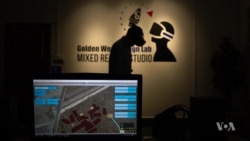A lab in Cambodia is using cutting-edge technologies such as virtual reality, augmented reality, machine learning, swarm robotics and 3-D printing to try and revolutionize bomb disposal.
The suite of products developed by Golden West Humanitarian Foundation's Phnom Penh lab, in collaboration with universities such as Massachusetts Institute of Technology and Villanova, are designed to mesh all these technologies together into a "total knowledge" toolkit for deminers.
Replica bombs created on 3-D printers in Phnom Penh that reveal the precise inner mechanics of a growing range of killing machines have already been sold to clients around the world, including the United Nations and the United States military.
Before that, Cambodian teams pioneered explosive ordinance harvesting, in which material recovered from unexploded bombs is recast into detonators used in the field to destroy mines and UXO, or unexploded ordnance.
Now Golden West, which is funded by the U.S. State Department's Office of Weapons Removal and Abatement, has turned its sights to the virtual world.
Cambodian-American Alan Tan, a former U.S. army bomb disposal tech and director of applied technology at Golden West, said Cambodians are using their country's painful experience to become world leaders in solving the crippling problem of explosive war remnants disposal.
"We're bringing this deeper and more thorough knowledge to our field, and I like to say democratizing explosive ordinance disposal so any country that has that need can have that need addressed even if they don't have a multibillion-dollar military budget to do it," he said.
Virtual bomb disposal
On a sunny afternoon, Tan throws large, unexploded bombs around in a (virtual) burned-out industrial park with reckless abandon.
The factory complex is an electronic canvass he is painting with familiar objects from the kind of bomb sites he regularly encountered in Iraq.
Thanks to a glitch in the matrix, a conga line of Humvees he's picked up and hauled across the concrete enclosure are stuck awkwardly in the sky.
"That looks like a glitch," the former deminer said, as he moved around in his virtual reality headset while others watched what he was seeing on a nearby monitor.
His virtual reality team, led by a Cambodian engineer, is debugging ahead of a launch of the Virtual EOD Training Room software at Ravens Challenge, the world's biggest bomb disposal expo in Thailand.
Tan is walking around in a Virtual EOD Training Center — a program his lab has created to speed up the process of teaching the most critical skill in the field: rapid risk assessment.
He changes mode to show observers generic objects from daily life available in the simulation, then accidentally drops a rubbish bag on one of the bombs he has thrown on the ground in front of him. Ka-boom!
But Tan is still alive, and that is one of the great assets virtual reality training brings to instructors — safe but immersive practice grounds.
Shifting scenarios
The other major benefit is that instructors can rapidly create a vast number of completely different bomb disposal scenarios to train students on various pressures they might encounter in the field — in a similar way to flight simulators.
Edwin Faigmane has trained U.N. peacekeepers in many of the world's worst conflict zones, including Afghanistan, South Sudan and Angola.
Faigmane, Chief Technical Advisor to the United Nations demining project in Cambodia, says the software would be particularly useful in training explosive ordinance disposal techs working as peacekeepers outside of their country, such as Cambodians who are being deployed in South Sudan.
"Virtual reality would let them feel, would let them experience, would let them see the surroundings for themselves and let them prepare their minds, so when they actually get into South Sudan, they know what they can expect," he said.
To help visualize the inner mechanisms of the many different bombs and land mines that EOD techs have to diffuse, Golden West has also developed augmented reality animations.
Using a smartphone held in a roughly $10 bifocal headset strapped to the head, a user's vision is replaced by a live point-of-view feed captured from the phone's camera.
With the aim of eventually connecting all these technologies together, one of the world's largest databases of explosive ordnance, with very high-resolution imaging and "open source" access for EOD techs, is being built.
Machine learning systems that work off these images are also under development to automate the identification of different types of explosives, although this technology is still in its infancy.
Al Johnston is a former U.S. army EOD tech and director of Ravens Challenge, which serves as both a testing ground and marketplace for technology manufacturers like Golden West.
Tools like these are particularly important, Johnston said, because traditional alternatives such as cutting open real versions of devices or accessing classified U.S. databases are prohibitively expensive and difficult to negotiate.
"That is really good because that gets the knowledge into more hands at the level that are actually encountering the UXO all over the world," he said.








